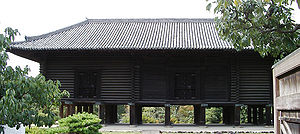

Azekura-zukuri (校倉造) or azekura is a Japanese architectural style of simple wooden construction, used for storehouses (kura), granaries, and other utilitarian structures. This style probably dates to the early centuries of the Common Era, such as during the Yayoi or Kofun periods. It is characterized by joined-log structures of triangular cross-section, and commonly built of cypress timbers.
See also
References
- "azekura 校倉". Japanese Architecture and Art Net Users System. 2001. Archived from the original on 2003-12-20. Retrieved 10 March 2021.
- ^ Louis Frédéric (2002). Japan Encyclopedia. Harvard University Press. p. 63. ISBN 978-0-674-01753-5. Retrieved 24 August 2012.
- "Azekura-zukuri | Japanese architecture".
| Elements of Japanese architecture | ||||||||||
|---|---|---|---|---|---|---|---|---|---|---|
| Styles |
|  Model of Himeji Castle | ||||||||
| Types of building |
| |||||||||
| Roof styles | ||||||||||
| Structural and spatial | ||||||||||
| ||||||||||
| Rooms | ||||||||||
| Furnishings | ||||||||||
| Partitions | ||||||||||
| Outdoor objects | ||||||||||
| Measurements | ||||||||||
| Organizations | ||||||||||
| Related topics |
| |||||||||
This article related to an architectural style is a stub. You can help Misplaced Pages by expanding it. |